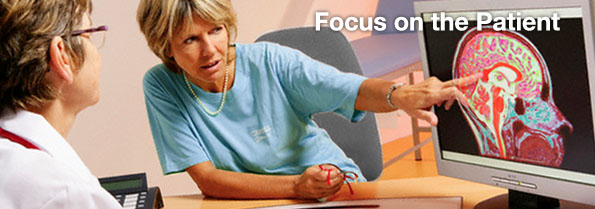CT scan
Brain Computerized Tomography (CT) Scan
The computerised tomography (CT scan) is a computerised analysis of several X-ray images taken from different directions to obtain a three-dimensional image of an object. In contrast to conventional X-rays, this process allows statements about the internal structure of an illuminated body.
The production of CT scans is based on the simultaneous detection of X-rays, which have permeated the body before. The comparison between outgoing and detected radiation intensity shows the attenuation (absorption) by the tissue, which is examined, whereby the absorption coefficient is specified in grey tones and by using the Hounsfield index (HI). Depending on the anatomical or pathological anatomical structure, the X-rays are differentially attenuated. Tissues with high radiation absorption (e.g. bone HI = 1000) are described as hyperattenuating and produce white greyscales, while tissues with low absorption (e.g. fat = - 90 HI, HI = 0 water, soft tissue = 50 HI) produce black greyscales and are called hypoattenuating. Since a multitude of different shades of grey can be produced, neoplasms, edema and necrosis can be differentiated from normal tissue.
Not in all cases is such a differentiation between various organ structures, as well as between healthy and diseased tissue, only with the described radiological method possible. This circumstance makes the administration of contrast agent necessary. These X-ray contrast agents are distinguished between those, that leads to an increased absorption of radiation to the surrounding tissue (positive x-ray contrast agent) and those, that can pass occurring radiation unhindered (X-rays negative contrast agent). The computerised tomography is primarily combined with injectable iodinated compounds to increase the image contrast and the visualisation of blood vessels. When choosing more expensive non-ionic iodinated contrast agents, side effects such as nausea, skin rashes and breathing problems are also kept to a minimum.
A disadvantage of computer tomography is the radiation exposure, which is up to 1000-fold higher than in the chest radiograph. The associated risk must be considered in the selection of the diagnostic method. However, the high significance of computer tomography can justify its implementation. As an alternative to CT, MRI is often proposed which is an imaging procedure as well, but does not require X-rays.






